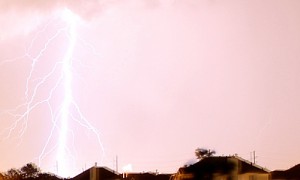In Dallas, there are numerous times throughout the year when you could experience a power outage. Ice storms, severe thunderstorms, the occasional tornado, and even high winds can cause a power outage; peak demand restrictions can affect your power as well. If you own a home in Dallas, here’s what you need to know about using a home generator during a power outage.
Portable Generators
A portable home generator is a temporary power solution and runs on unleaded gasoline. These will use between 8–12 gallons of fuel a day. Because of their portable nature, they’re handy during a weather emergency like a hurricane, a severe storm, or any short-term emergency. This is also a less expensive option than an installed generator. A 1,000-watt portable generator can cost as little as $150. However, don’t wait until the next emergency to buy a portable generator. Take the time to prepare before the next disaster strikes.
Installed Home Generators
An increasingly popular solution is to install a permanent generator next to your home using natural gas or liquid propane. This solution can allow your home to have power for longer, and without you having to haul heavy equipment. Typically, these units come prewired and ready to install on a mounting pad in your yard.
An authorized dealer and technician will work with you to assess your needs and install the equipment for you. You can choose additional features, such as technology that allows you to control the generator with your mobile phone or other Internet-enabled device, auto-start functions, a transfer switch, and maintenance features such as automatic weekly system tests to ensure the engine is properly primed. Installing a permanent generator is a long-term investment, which can increase your property’s value.
How to Choose a Generator
When considering which generator to choose, look at the type of usage you intend. Will you be running your whole house off the generator, or only critical items like the refrigerator and freezer? Are you comfortable with starting and maintaining a generator yourself, or would you prefer more automation? What’s your budget? What space do you have available for a generator?
Using a Generator Safely
Whether you choose a portable generator or an installed permanent generator, it’s important to use it safely.
- Be sure never to overfill a portable generator. Always leave about a half-inch of open space in the fuel tank for expansion.
- Calculate your usage carefully. There are several different online calculators, including ones from Generac and Consumer Reports. Speak with an installation expert to make sure you have calculated the wattage needs correctly and properly anticipated your needs.
- Don’t plan to use 100 percent of the generator’s capacity. This will prevent overtaxing the startup, tripping the generator’s circuit breaker, or overheating your appliances.
- Be careful regarding carbon monoxide, which is odorless, colorless, and potentially lethal. One portable generator can create more than 100 times the amount of carbon monoxide as a running car. The US Fire Administration and FEMA offer safety tips regarding carbon monoxide. Keep the generator a safe distance away from the home, taking into account open windows or intakes; be aware of wind conditions that can change the direction of exhaust; and never run a generator indoors, even in an open garage. Use carbon monoxide detectors throughout your home to alert you to the presence of carbon monoxide.
When you choose the right generator for your home, you’ll always be prepared to keep your lights going and your appliances running, no matter the situation.
Image Source: Flickr/Jay Flaxman
[cf]skyword_tracking_tag[/cf]







[…] Home Generator: What Every DFW Homeowner Should Know […]
[…] post Home Generator: What Every DFW Homeowner Should Know appeared first on Coldwell Banker Blue […]
[…] Be careful regarding carbon monoxide, which is odorless, colorless, and potentially lethal. One portable generator can create more than 100 times the amount of carbon monoxide as a running car. The US Fire Administration and FEMA offer safety tips regarding carbon …read more […]